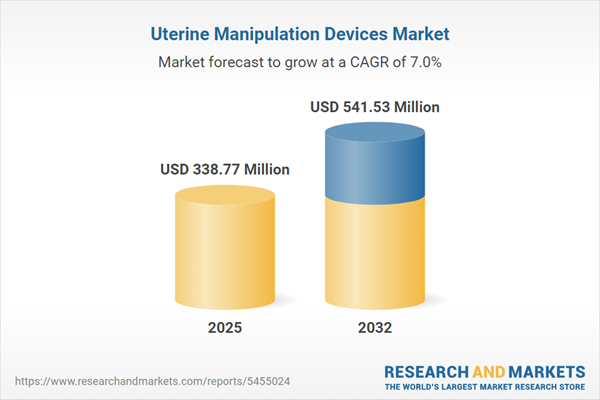Speak directly to the analyst to clarify any post sales queries you may have.
The uterine manipulation devices market is undergoing significant transformation as technological innovation, new surgical protocols, and evolving regulations converge. Senior healthcare executives are tasked with aligning device adoption to compliance, operational efficiency, and improved patient care standards in women’s health.
Market Snapshot: Uterine Manipulation Devices Market Overview
The global uterine manipulation devices market was valued at USD 316.29 million in 2024 and is expected to reach USD 338.77 million in 2025, with projections indicating growth to USD 541.53 million by 2032. Market expansion is driven by the increased uptake of minimally invasive procedures, particularly in hospitals and alternate care sites. Device makers are investing in novel technologies to meet regulatory benchmarks and clinical workflow needs. Regional patterns in purchasing and product preferences underscore the need for tailored commercial strategies, allowing leaders to adapt to diverse healthcare system demands and compliance environments worldwide.
Scope & Segmentation
- Product Types: Disposable mechanical systems are prioritized for enhanced infection control and seamless single-use implementation. Disposable pneumatic inflatable devices are leveraged for added procedure safety. Reusable articulating platforms are adopted to boost ergonomic efficiency for operative teams. Manual screw devices provide cost-conscious, customizable solutions for institutions seeking reduced long-term expenditure.
- Clinical Applications: Uterine manipulation devices support a broad scope of gynecologic surgeries. They are crucial in robot-assisted and conventional hysterectomy and myomectomy, and are regularly applied during hysteroscopic and laparoscopic procedures. Their utilization enhances intraoperative visualization, control, and precision during complex interventions.
- End Users: Principal end users include hospitals, ambulatory surgical centers, outpatient clinics, and tertiary care facilities. Procurement criteria emphasize infection avoidance, streamlined operation, and adaptability for procedures with variable complexity and patient throughput.
- Distribution Channels: Access is sustained via direct manufacturer sales, specialty distributors, original equipment manufacturing collaborations, digital procurement platforms, and third-party marketplaces to reinforce supply chain dependability and market reach.
- Regional Coverage: Regulatory landscapes and healthcare delivery models create regional differentiation across North America, Latin America, Europe, Middle East, Africa, and Asia-Pacific, impacting technology selection and pace of product integration.
- Notable Companies Covered: Providers such as Ethicon, Karl Storz, Medtronic, B. Braun, ConMed, CooperSurgical, Richard Wolf, Stryker, Smith & Nephew, and Teleflex Incorporated continue to enhance device integration and support advancements in operative environments.
Key Takeaways for Senior Decision-Makers
- Broader adoption of uterine manipulation devices is expediting minimally invasive surgical trends and supporting greater procedural standardization across care settings.
- Developments in device automation, robotics, and ergonomic design foster collaboration among surgical, clinical, and operational stakeholders, enabling wider applications within women’s health.
- Close cooperation among manufacturers, clinicians, and regulators enhances product oversight and advances streamlined compliance protocols.
- Procurement priorities are increasingly directed at configurable device platforms and rigorous infection prevention, optimizing operational outcomes in both high- and low-volume surgical settings.
- Hybrid device models combining mechanical and pneumatic components are simplifying workflow integration and accommodating differentiated market requirements.
- Localization of product features and customization in response to regional clinical practices and regulatory distinctions allow organizations to adapt strategies and better serve emerging and mature markets.
Tariff Impact and Supply Chain Resilience
- Forthcoming changes in tariffs prompt executive teams to reassess pricing approaches, renegotiate contract terms, and implement refined cost-control measures to maintain financial reliability.
- Manufacturers are securing continuity by expanding sourcing options and forging new supplier partnerships, ensuring resilience against potential market and regulatory volatility.
- Maintaining ongoing compliance and a robust, diversified supply network is vital to effectively respond to shifting regulatory demands and sector disruptions.
Methodology & Data Sources
Research for this report draws on direct interviews with surgeons, supply chain leaders, and hospital administrators. Findings are verified with evidence from clinical registries, regulatory sources, and respected third-party research to deliver a comprehensive, trustworthy view of the uterine manipulation devices market’s present and emerging trajectories.
Why This Report Matters
- Manufacturers and supply chain decision-makers receive actionable insights to guide product development and adjust distribution models in line with current regulatory and market changes.
- Procurement and executive teams benefit from intelligence designed to refine operations, allocate resources effectively, and drive measurable value for their healthcare organizations.
- Investors and new sector entrants can leverage focused analysis on market drivers and positioning to inform strategy in women’s health technology innovation.
Conclusion
Strategic assessment of the uterine manipulation devices market enables organizations to anticipate sector shifts, manage risk, and build sustainable competitive advantage in an evolving healthcare environment.
Additional Product Information:
- Purchase of this report includes 1 year online access with quarterly updates.
- This report can be updated on request. Please contact our Customer Experience team using the Ask a Question widget on our website.
Table of Contents
3. Executive Summary
4. Market Overview
7. Cumulative Impact of Artificial Intelligence 2025
Companies Mentioned
The companies profiled in this Uterine Manipulation Devices market report include:- Ethicon, Inc.
- Karl Storz SE & Co. KG
- Medtronic PLC
- B. Braun Melsungen AG
- ConMed Corporation
- CooperSurgical, Inc.
- Richard Wolf GmbH
- Stryker Corporation
- Smith & Nephew PLC
- Teleflex Incorporated
Table Information
| Report Attribute | Details |
|---|---|
| No. of Pages | 181 |
| Published | November 2025 |
| Forecast Period | 2025 - 2032 |
| Estimated Market Value ( USD | $ 338.77 Million |
| Forecasted Market Value ( USD | $ 541.53 Million |
| Compound Annual Growth Rate | 6.9% |
| Regions Covered | Global |
| No. of Companies Mentioned | 11 |









